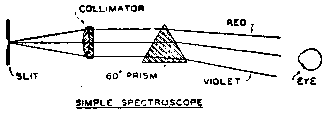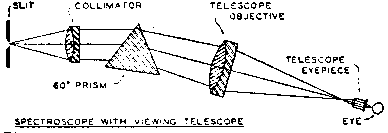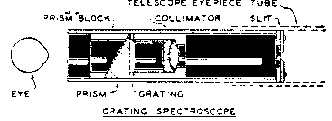John M. Pierce's Telescope Making Articles
These articles are reproductions from the magazine of the '30s, Everyday Science and Mechanics.
Spectroscopes.
Part 14
 The spectroscope breaks up a beam of light into its various colors. White light is a mixture of all colors, and the spectroscope spreads these out into a band of varying colors running from dark red at one edge, through orange, yellow, green, blue to violet at the other extreme.
The spectroscope breaks up a beam of light into its various colors. White light is a mixture of all colors, and the spectroscope spreads these out into a band of varying colors running from dark red at one edge, through orange, yellow, green, blue to violet at the other extreme.
There are two principal types of spectroscopes: those which use a prism to spread out the light, and those in which a diffraction grating is used for the purpose. If a narrow slit is used to limit the beam of light, the colors become very pure with little overlapping and, where a color is missing in the light source, a black line appears in the spectrum. When sunlight is observed, these black lines appear by hundreds, and are known by the name of their discoverer as Fraunhofer lines.
 A spectroscope consists of a slit placed at the primary focus of the lens, preferably achromatic, which transmits the light as a parallel beam to the prism or grating; after which it may be viewed with the unaided eye, or by means of a small telescope if more magnification is wanted.
A spectroscope consists of a slit placed at the primary focus of the lens, preferably achromatic, which transmits the light as a parallel beam to the prism or grating; after which it may be viewed with the unaided eye, or by means of a small telescope if more magnification is wanted.
Fig. 1 is a diagram of a single prism spectroscope and Fig. 2 shows a viewing telescope attached.
With this type of spectroscope, the telescope should be arranged to swing around a pivot located at the prism, so that it fall in line with the refracted optical axis.
 A somewhat simpler and more powerful spectroscope sues a diffraction grating as the dispersing element: the grating is made with from 5,000 to 25,000 lines per inch, ruled on a flat surface of glass. Such a grating is very expensive; but a replica grating (made by placing a thin coat of collodion on an original grating and then stripping it off when it dries) will serve the amateur's purpose just as well. This collodion replica reproduces the lines of the original grating and, if held to the light, shows a brilliant spectrum - or rather several, since the grating forms a number of different spectra on each side of the center line.
A somewhat simpler and more powerful spectroscope sues a diffraction grating as the dispersing element: the grating is made with from 5,000 to 25,000 lines per inch, ruled on a flat surface of glass. Such a grating is very expensive; but a replica grating (made by placing a thin coat of collodion on an original grating and then stripping it off when it dries) will serve the amateur's purpose just as well. This collodion replica reproduces the lines of the original grating and, if held to the light, shows a brilliant spectrum - or rather several, since the grating forms a number of different spectra on each side of the center line.
Fig. 3 is a diagram of such a spectroscope, with a 30 degree prism inserted in front of the eye; so that the observer doesn't not have to observe at an angle as in Figs. 1 and 2.
We will now describe the construction of this spectroscope.
The optical parts needed are a 30 degree prism about 1 inch square, an achromatic lens of about 3 inch focus, and a replica grating. (The lens and prism may be made as described in Parts 6 and 8 of this series of articles, which appeared in the March and May 1934 issues of Everyday Science and Mechanics.)
 The replica grating can be purchased for a small sum.
The replica grating can be purchased for a small sum.
You will need a piece of brass tubing, 1 1/4 inches on the outside diameter by about 5 inches long. One end is soldered, and the slit assembly made as shown in Fig. 4A. This consists of a 1 1/4 inch circle of 1/16 inch thick sheet brass with a 3/8 inch hole drilled at the center. To this are fastened, by No. 2 machine screws, the two blades which form the slit: their edges should be filed clean and true, and a piece of paper is place between them to give them an even separation while they are screwed in place. After this the paper is withdrawn, leaving the slit opening.
 The lens is mounted in a metal or wooden carrier, so that it may be slid in the tube to focus accurately on the slit when the eye is held at the opposite end of the tube. A headless screw or rivet should then be inserted to hold it in place.
The lens is mounted in a metal or wooden carrier, so that it may be slid in the tube to focus accurately on the slit when the eye is held at the opposite end of the tube. A headless screw or rivet should then be inserted to hold it in place.
Fig. 4B shows a suggested way of holding the lens. The grating may be held between the lens holder and the prism. Fig. 4C details this angle block and shows how the prism is held in the tube, between the angle block and the lens holder. The angle block may be soldered, screwed or riveted in place. Before fastening prism block, turn the grating until the spectrum of the slit is perpendicular to the slit itself. Then the angle block is placed so that the triangular faces of the prism are perpendicular to the line of the slit.
Fig. 4D shows an assembly of the completed instrument. If it is pointed at the sun, the black Fraunhofer lines should be clearly seen. In use with the telescope, the spectroscope is pushed into the eyepiece tube until the slit is at the primary focus of the concave mirror or objective lens. If the telescope is pointed at the sun, and the edge of the sun's disc is brought to fall on the slit, any prominence appearing at this place on the sun can be seen on the heavy dark C line (the most prominent line in the red portion of the spectrum). When observing the prominences, the slit should be set for about 1/32 inch wide, and a view telescope used to enlarge the image. For this purpose any small telescope can be used.
A finder telescope, fitted with a sleeve to slip on the spectroscope, will work nicely; or, if desired, a telescope may be built into the spectroscope as shown in Fig. 5.
 The spectroscope breaks up a beam of light into its various colors. White light is a mixture of all colors, and the spectroscope spreads these out into a band of varying colors running from dark red at one edge, through orange, yellow, green, blue to violet at the other extreme.
The spectroscope breaks up a beam of light into its various colors. White light is a mixture of all colors, and the spectroscope spreads these out into a band of varying colors running from dark red at one edge, through orange, yellow, green, blue to violet at the other extreme. A spectroscope consists of a slit placed at the primary focus of the lens, preferably achromatic, which transmits the light as a parallel beam to the prism or grating; after which it may be viewed with the unaided eye, or by means of a small telescope if more magnification is wanted.
A spectroscope consists of a slit placed at the primary focus of the lens, preferably achromatic, which transmits the light as a parallel beam to the prism or grating; after which it may be viewed with the unaided eye, or by means of a small telescope if more magnification is wanted. A somewhat simpler and more powerful spectroscope sues a diffraction grating as the dispersing element: the grating is made with from 5,000 to 25,000 lines per inch, ruled on a flat surface of glass. Such a grating is very expensive; but a replica grating (made by placing a thin coat of collodion on an original grating and then stripping it off when it dries) will serve the amateur's purpose just as well. This collodion replica reproduces the lines of the original grating and, if held to the light, shows a brilliant spectrum - or rather several, since the grating forms a number of different spectra on each side of the center line.
A somewhat simpler and more powerful spectroscope sues a diffraction grating as the dispersing element: the grating is made with from 5,000 to 25,000 lines per inch, ruled on a flat surface of glass. Such a grating is very expensive; but a replica grating (made by placing a thin coat of collodion on an original grating and then stripping it off when it dries) will serve the amateur's purpose just as well. This collodion replica reproduces the lines of the original grating and, if held to the light, shows a brilliant spectrum - or rather several, since the grating forms a number of different spectra on each side of the center line. The replica grating can be purchased for a small sum.
The replica grating can be purchased for a small sum. The lens is mounted in a metal or wooden carrier, so that it may be slid in the tube to focus accurately on the slit when the eye is held at the opposite end of the tube. A headless screw or rivet should then be inserted to hold it in place.
The lens is mounted in a metal or wooden carrier, so that it may be slid in the tube to focus accurately on the slit when the eye is held at the opposite end of the tube. A headless screw or rivet should then be inserted to hold it in place.